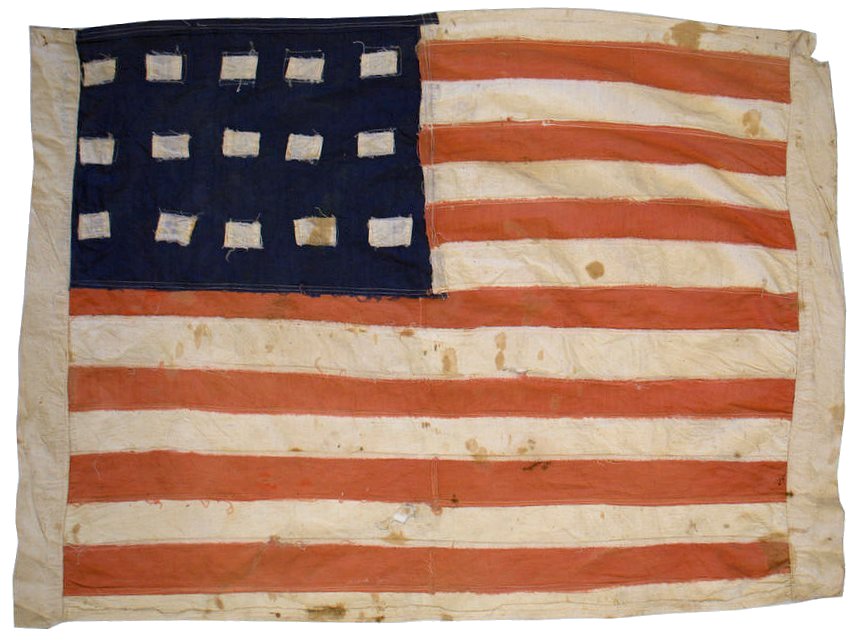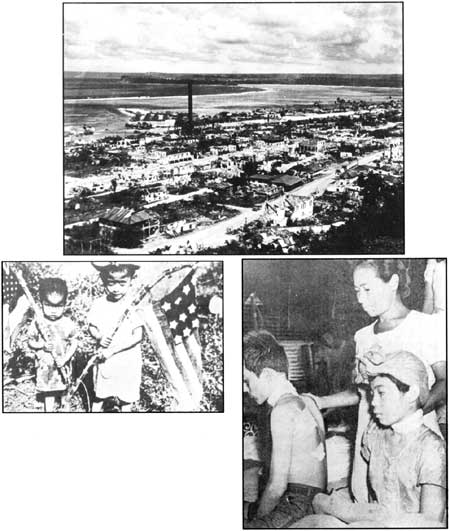|
 This
wonderful rare flag returned home from Japan at the
conclusion of World War II in the footlocker of Marine
Corps Sergeant Martin H. Moder. A cherished keepsake
from the battlefields of the Pacific Theater, it remains
an exceptional survivor from one of the most brutal and
hard-fought military campaigns in American history.
Close examination of the flag leads to the conclusion
that this flag was a Pacific-made liberation flag, most
likely made to welcome the Americans liberating one of
the Asia Pacific island nations, perhaps Okinawa, from
occupation by the Japanese. Very faded writing on the
hoist in Asian characters is a first indication that it
was made indigenously. The most striking immediate characteristic of this flag
is its fifteen rectangular "stars", unique in my
experience on any American flag I've witnessed.
The flag, with its folky appearance, has all of the
hallmarks of a liberation flag, where the creators were
familiar with the form of the American flag, but not
with specific details. In addition, a top
and bottom white stripe makes this a fifteen-star,
fifteen-stripe flag resulting in a touching, if perhaps
unintended, linkage between it and our nation's most
cherished fifteen-star and fifteen-stripe flag, the Star
Spangled Banner. Clearly a wartime flag, it also
exhibits another rare attribute of its canton resting on
the red "blood stripe", which,
according to American flag lore, indicates
a flag made during wartime, and which certainly holds
true in the case of this flag. Since the flag was
made by foreign hands, these attributes are mere
coincidences, but nevertheless are fascinating and rare.
The staining and soiling of the flag are original and
reflect the condition of the flag as it returned from
the battlefield during operations in the Pacific circa
1945. Although it would take further testing to confirm,
some of the brown staining of the flag may in fact be
blood. This
wonderful rare flag returned home from Japan at the
conclusion of World War II in the footlocker of Marine
Corps Sergeant Martin H. Moder. A cherished keepsake
from the battlefields of the Pacific Theater, it remains
an exceptional survivor from one of the most brutal and
hard-fought military campaigns in American history.
Close examination of the flag leads to the conclusion
that this flag was a Pacific-made liberation flag, most
likely made to welcome the Americans liberating one of
the Asia Pacific island nations, perhaps Okinawa, from
occupation by the Japanese. Very faded writing on the
hoist in Asian characters is a first indication that it
was made indigenously. The most striking immediate characteristic of this flag
is its fifteen rectangular "stars", unique in my
experience on any American flag I've witnessed.
The flag, with its folky appearance, has all of the
hallmarks of a liberation flag, where the creators were
familiar with the form of the American flag, but not
with specific details. In addition, a top
and bottom white stripe makes this a fifteen-star,
fifteen-stripe flag resulting in a touching, if perhaps
unintended, linkage between it and our nation's most
cherished fifteen-star and fifteen-stripe flag, the Star
Spangled Banner. Clearly a wartime flag, it also
exhibits another rare attribute of its canton resting on
the red "blood stripe", which,
according to American flag lore, indicates
a flag made during wartime, and which certainly holds
true in the case of this flag. Since the flag was
made by foreign hands, these attributes are mere
coincidences, but nevertheless are fascinating and rare.
The staining and soiling of the flag are original and
reflect the condition of the flag as it returned from
the battlefield during operations in the Pacific circa
1945. Although it would take further testing to confirm,
some of the brown staining of the flag may in fact be
blood.
Born in 1909 in House Springs, Jefferson County,
Missouri, Martin Moder served in the Pacific Theater
during World War II. The flag remained untouched in Martin's
footlocker in a barn in House Springs until 1998, when
it was given to the immediate family member from which
the flag was acquired. The flag was then placed in
a bag and kept in a cabinet, until it was acquired for
the Rare Flags collection.
 Pacific
theater liberation flags are very scarce, but they are
documented and were made as American forces moved
through the Pacific liberating territory from Japanese
control. These photos of Guam from the National Park
Service site show children holding homemade liberation
flags. Pacific
theater liberation flags are very scarce, but they are
documented and were made as American forces moved
through the Pacific liberating territory from Japanese
control. These photos of Guam from the National Park
Service site show children holding homemade liberation
flags.
"Agana is left in ruins after the
invasion. Though the city never regained its pre-war
status as the island's main residential center, the
people of Guam were able to rebuild their lives. They
did so by first joining in the war effort as part of the
military economy supplying and supporting U.S. forces
fighting their way to Japan, then rebuilding and
reshaping Guam in the postwar era (top).
Soon after the Liberation, two boys hold handmade
American flags. The scene is reminiscent of when U.S.
forces first came upon groups of Chamorros and were
greeted by people waving aloft the Stars and Stripes -
the flags in various shapes and sizes but nevertheless
still the Stars and Stripes (bottom, left).
16-year-old Juan Cabrera and 15-year-old Beatrice Perez
(Emsley) are treated for their wounds. In the days just
before the July 21 invasion, the two youths were among
people found in Agana and arrested by Japanese soldiers.
After being held in a cave for two days and given no
food and water, the 11 people were told to kneel before
a bomb crater. An order was given and they were struck
down by soldiers' swords and bayonets and left to die.
Juan, who suffered five deep bayonet wounds, and
Beatrice, all of her neck muscles severed, were the only
ones to survive the execution. Beatrice, now 65, has
several times testified before federal officials and
Congress regarding war reparations to the Guamanian
people. Her plea for justice and those of others has
been, unfortunately, ignored (bottom, right)."1
1
https://www.nps.gov/parkhistory/online_books/npswapa/extContent/Lib/liberation32.htm
|

